Never Give Up
Never Give Up
Even when the vets weren’t hopeful, Kelly Cummins decided to give Finally Hes Charming his best chance
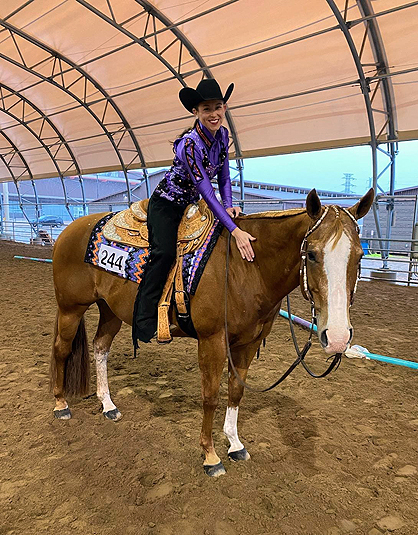
Kelly and Seymour at their comeback show, Copper Country POR, in January 2023
By Delores Kuhlwein
Kelly Cummins knew before he fell ill that Finally Hes Charming had the biggest heart she’d ever seen in a horse. But when he developed a deadly septic hock and had to fight for his life, she truly understood the depth of his heart and soul.
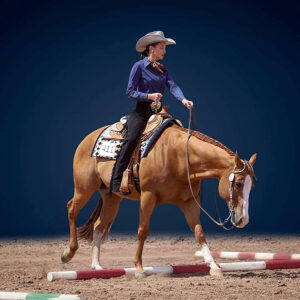
Photo credit: Marilyn Van De Graaff
Anyone who watched exhibitor Kelly compete with her heart horse, “Seymour”, in APHA, AQHA, and Pinto shows over many years could see they had a bond. He gave of himself so freely to her after she purchased him in 2015, they earned countless titles together: multiple World Champion, National Champion, multiple APHA Top 10 (end of year), multiple #1 APHA Zone 2, multiple #1 in Arizona APHC, PtHA Horse of the Year, APHA Versatility Award, Superiors in all events shown, and innumerable highpoints.
In fact, their past trainer affectionately referred to him as “Seymour the Wonder Horse” and it stuck. “That nickname now suits him more than ever,” reveals Kelly.
An Abrupt Change
Her dedication to him in return matched his selfless effort, and in addition to a comprehensive feed and maintenance program, one of her commitments to his care included cameras in the barn at their Marana residence, just outside Tucson, Arizona. “After I got him out to ride on a Sunday morning at the end of May 2022, I noticed his leg was swollen. I looked back on the cameras to see what happened. We couldn’t see an insect on the camera footage, but we saw that all of a sudden he was frantically kicking and biting at his hock. I knew at that moment that it was an insect. He has always been a very “allergic” horse and has had multiple severe reactions to insect bites in the past,” she says.
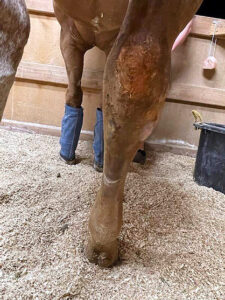 Since Seymour had experienced cellulitis previously, Kelly and her husband, Gary, knew the drill and began treatment. As a Pharmaceutical Doctor, Kelly also knew how to be methodical and meticulous about treating the condition.
Since Seymour had experienced cellulitis previously, Kelly and her husband, Gary, knew the drill and began treatment. As a Pharmaceutical Doctor, Kelly also knew how to be methodical and meticulous about treating the condition.
When Seymour didn’t show improvement, they reached out to their backup vet, since their regular one was on vacation. “They agreed with me that it looked like cellulitis and treated it as such with more medication,” Kelly explains.
But another day of him continuing to decline, to the point of being 3-legged, caused Kelly to reach out to her regular vet, who was now available and immediately came to the barn to place an IV. “He was so miserable he didn’t even get up when she placed it,” reveals Kelly. “She told me to aggressively treat the cellulitis and if he did not improve in the next 24 hours to immediately take him to an internal medicine specialist in Phoenix. Unfortunately, he continued to decline, so off to Phoenix he went.”
They made the 2-hour trip to Phoenix, and the internal medicine specialist ran some tests. It turned out Seymour had a septic hock, the result of the insect bite, which would require immediate surgery.
The Only Answer: Surgery
Then they transported Seymour to be operated on by Dr. Howard at Arizona Equine Center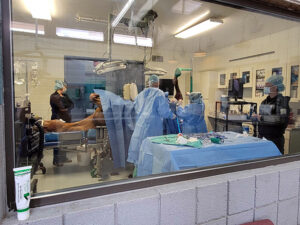 in Gilbert Arizona, where he underwent an extensive procedure under full anesthesia that took almost 4 hours.
in Gilbert Arizona, where he underwent an extensive procedure under full anesthesia that took almost 4 hours.
“I was able to watch the entire thing,” reveals Kelly. “Dr. Howard literally scrubbed and washed the entire inside of the joint with antibiotics in order to hopefully resolve the infection. At that time, his prognosis was not good. He gave him a 10% chance of ever being show sound again, a 30% chance of being ridable again, and a 60% chance of living.”
Though the surgery went well, Dr. Howard informed Kelly that it would have to be repeated if there was not enough improvement. Unfortunately, on Day 5 post-surgery, Seymour went under again for another 3 ½ hour surgery to repeat the process.
“He was in intensive care for 10 days and still was not improving to the surgeon’s wishes, but he said never in his (long) career had he done the procedure 3 times. So we decided to take him home anyway as he was just very depressed at the hospital, and I knew he would have a better chance of recovery at home. We then started the long process of multiple meds, bandage changes, and complete stall rest with only very brief walking sessions twice daily for the next month,” explains Kelly.
Home: The Best Medicine
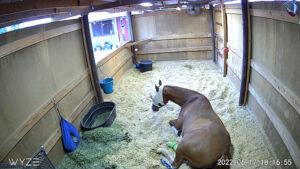 When they got him home, he became better both mentally and physically, and at the 30-day mark, they started therapy boots twice daily, red light therapy once daily, and a very small area of turnout.
When they got him home, he became better both mentally and physically, and at the 30-day mark, they started therapy boots twice daily, red light therapy once daily, and a very small area of turnout.
“At the 60 day mark is when we really started to see some improvement,” Kelly says. “At that point he was off all meds, allowed to walk longer, and were allowed to expand his pasture area again.”
Then at the 90-day mark, they knew Seymour was going to make it. He had improved so much, the surgeon gave Kelly permission to start exercising him under saddle in small doses. They started for 15 minutes a few times a week, and gradually increased, meanwhile continuing ICEVIBE boot treatments twice daily and red light therapy a few times a week.
Hope On the Horizon
Going from wondering if Seymour would live, or ever be sound again, began to give way to the possibility of showing again a few months later. They decided to attend one of their favorite shows, the January portion of the APHC Copper Country POR in Scottsdale. “I didn’t really mean for our first show back to be one of the biggest APHA shows in the country, but that is how it happened,” reveals Kelly.
Though they would have done all Open and Amateur classes in the past, they just focused on Showmanship, Equitation, Horsemanship, Trail and Western Riding. When they arrived, all of Kelly’s fears were put to rest after Seymour showed her he was ready in the only way he could.

Photo credit: Don Trout Photography
“When we got to the show grounds, I decided to walk him down to the Equidome (the indoor arena) and it was at that moment that I knew I had made the right decision,” Kelly explains. “I could barely hold him back from trotting. He was pulling on me, he was walking so quickly, which is very unlike him (normally very mannered). He was so happy and relaxed once he got in the arena. He has always loved his job and absolutely loves showing. That was solidified at this show simply by looking at him. He was so happy and had such an amazingly positive attitude the whole show….even in the rain, wind, and cold! We ended up doing very well placing top 5 overall in almost every class, as well as earning a circuit championship in Trail (his best event) and multiple reserve circuit championships.”
Lessons Learned
Kelly says she knew before this happened Seymour has the biggest heart she’s ever known in a horse. She discovered early on that he’s extremely sensitive in the saddle, and she had to learn how to be quiet and talented to excel with him. “But he will give 110% every time you step in those stirrups. Every day, every time, every show. If you treat him well he will give you his all. I honestly have never had a “bad” day on him,” she acknowledges.
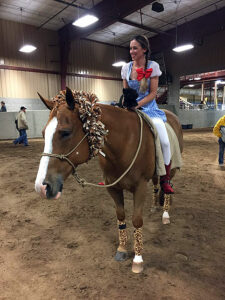 She also now understands the importance of the care she’d already committed to giving him as a senior horse. “I have been dedicated to my horses for my entire life. My father taught me long ago if you take care of something, it will last. I have applied that logic to my horses, Seymour included,” she says. “From the beginning I have always given him everything an equine athlete should have that competes at a high level: regular massage therapy (Masterson method), chiropractic/osteopathic therapy, PEMF, red light therapy, and top-of-the-line nutrition. Honestly, the only thing I have added since his injury are the ICEVIBE boots.”
She also now understands the importance of the care she’d already committed to giving him as a senior horse. “I have been dedicated to my horses for my entire life. My father taught me long ago if you take care of something, it will last. I have applied that logic to my horses, Seymour included,” she says. “From the beginning I have always given him everything an equine athlete should have that competes at a high level: regular massage therapy (Masterson method), chiropractic/osteopathic therapy, PEMF, red light therapy, and top-of-the-line nutrition. Honestly, the only thing I have added since his injury are the ICEVIBE boots.”
Kelly explains she didn’t hesitate to spend hours a day taking care of him, up early before work and late at night after work, because she knew Seymour was always willing to give everything to her. She says, “He is a truly dedicated horse and deserves every ounce of my dedication in return.”
The Takeaway
Above all, she recommends never giving up on your horse, even when vets don’t necessarily provide good news. “I had to give up a lot to keep him alive, including my 2-year-old prospect that was going to be his replacement when he retires in order to pay his medical bills.”
She adds, “I have to thank one of my good friends for telling me 3 things to say every day that really helped me emotionally….”you will get better, you will recover, you just have to stay positive…”. I still say this to him every day.”
The life-altering experience also convinced Kelly that the hard work she’d always believed in was truly a blessing. “I think this experience just shows that if you give your all, that sometimes miracles happen.”
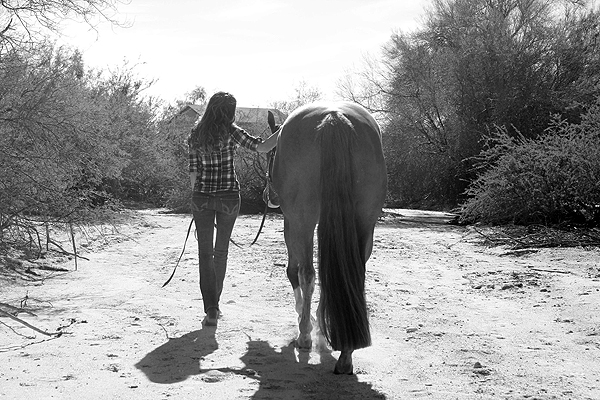
Photo credit: Jami O’Rourke










